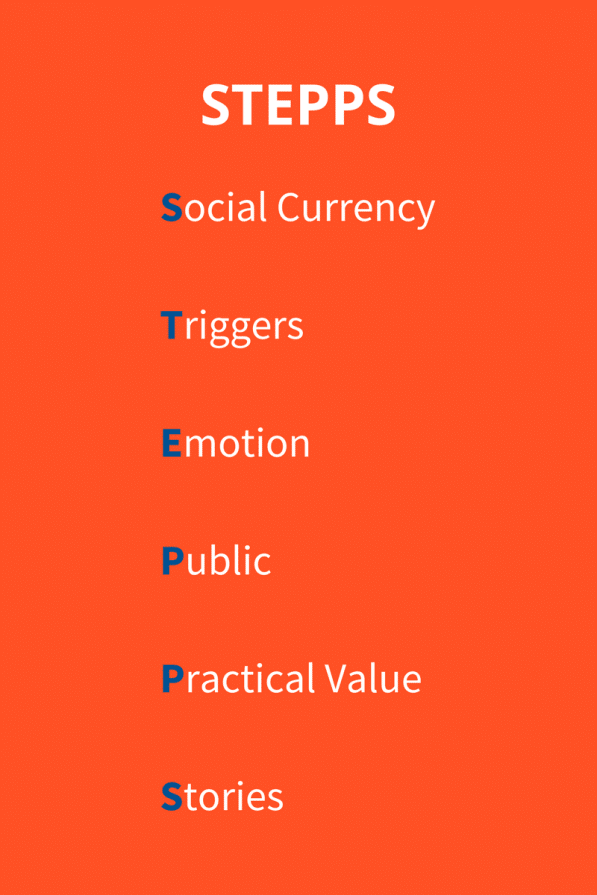People love a good success story. But maybe no one likes them more than Jonah Berger.
The bestselling author of Contagious: Why Things Catch On and future star of our next webinar, Dr. Berger has spent the last decade researching what makes things popular. From the back flap of Contagious: “He’s studied how ideas spread, what drives word of mouth, why online content goes viral, and how social influence shapes everything from the cars we buy to the names we give our children.”
And what he’s found is enough to fill a book…obviously.
Contagious puts forth the idea that there are six factors that contribute to a thing’s virality. Berger calls them STEPPS.

Now you don’t need to tap into all six to give your product or idea the best chance of dizzying success, but the more the better, and you definitely need at least one.
Here are three STEPPS success stories:
1. Rue La La
We care about how we look to others. Jonah Berger knows this; it’s why the first S in his STEPPS is devoted to “social currency”. Rue La La also knows this.
In 2005, Ben Fischman became CEO at a discount website called SmartBargains.com. It bought clearance items from other companies on the cheap, and passed those savings onto its customers. The model was good, but within two years, the shine had worn off. People were no longer excited about the brand, and competitors were moving in. So Fischman started Rue La La.
Rue La La is a website that provides flash sales on designer goods. The catch is that you have to be a member. And more than that, in the beginning you had to be invited to become a member by another member. Sales exploded.
The most remarkable thing about Rue La La was that its merchandise was — you might have seen this coming — the exact same as SmartBargain.com’s. The exact same. Yet the former was pulling in unspeakable amounts of money, while the latter was floundering. That’s the power of exclusivity.
Social currency — the first of Jonah Berger’s STEPPS — dictates that people like to feel like insiders. And even more, they like to be seen by others as insiders. And that’s what membership in Rue La La gave them.
2. Kit Kat
It’s a tried and true technique of teenagers everywhere: get in with the cool kids, and you’ll become more popular. The same premise applies to marketing your product or idea: associate it with something people already love, and there’s a good chance they’ll start to love your thing too. Enter Kit Kat.
In 2007, 31 years after the introduction of that unforgettable jingle, Kit Kat needed a boost. Sales were down, and getting worse, declining by around five percent a year. So Colleen Chorak, Hershey’s marketing director, went to work.
She did some research, and found that people often ate their Kit Kat bars with a hot beverage. Quick! Name a hot beverage! Kit Kat and coffee was born.
Chorak and her team launched a campaign painting the chocolate bar as coffee’s best friend. In every ad, they were always together, side by side. And the effect was that, when people thought of coffee, they started also thinking of Kit Kat. By the end of the year, sales were up by eight percent.
Chorak had created a trigger — the second of Jonah Berger’s STEPPS — allowing an already popular something to piggyback her product to sales success.
3. Google
Even with its reputation as a fun and far-out place to work, Google has always been known more as a place for techies than for designers. That was certainly the case in 2009.
Back then, Google tasked its newly formed Creative Lab with creating a piece of content highlighting the functionality of Google’s new search interface.
The techies suggested a how-to video and an online trivia game. These would show people the features of the interface, they argued. But graphic designer Anthony Cafaro felt something more was needed: emotion.
He believed that the best way to showcase the interface was to use it to tell a story, a touching story. Here’s what the team came up with:
See what happened? You felt something. Maybe you smiled. Maybe your heart fluttered a bit. But you definitely felt something. Now, how likely are you to want to show this video to someone else?
Emotion — the third of Jonah Berger’s STEPPS — relies on the premise that when we care, we share. At time of writing, Parisian Love had nearly eight million views on YouTube. Who wouldn’t want that kind of exposure?
Ahhhhh success stories. AAAHHHHHH STEPPS SUCCESS STORIES! If you liked these, and want to learn more about all six STEPPS and how to craft your own contagious content, register for our free webinar with Jonah Berger coming up on June 13.







